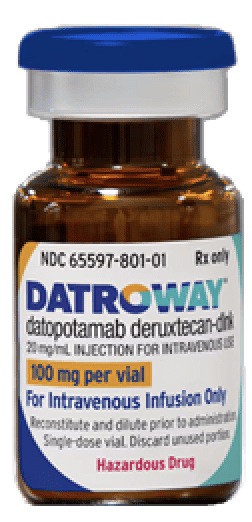Datroway Side Effects
Generic name: datopotamab deruxtecan
Medically reviewed by Drugs.com. Last updated on Aug 10, 2025.
Note: This document provides detailed information about Datroway Side Effects associated with datopotamab deruxtecan. Some dosage forms listed on this page may not apply specifically to the brand name Datroway.
Applies to datopotamab deruxtecan: intravenous powder for injection.
Important warnings
This medicine can cause some serious health issues
Tell your doctor if you use other medicines or have other medical conditions or allergies.
Get emergency medical help if you have signs of an allergic reaction: hives, difficult breathing, swelling of your face, lips, tongue, or throat.
Call your doctor at once if you have:
-
fever, chills, cough with mucus, chest pain, feeling short of breath, wheezing, trouble breathing;
-
dry eyes or watery eyes, blurred vision;
-
signs of eye infection--swelling, redness, severe discomfort, crusting or drainage;
-
feeling like something is in your eye; or
-
blisters or ulcers in your mouth, red or swollen gums, trouble swallowing;
Common side effects may include:
-
tiredness;
-
low blood calcium --muscle spasms or contractions, numbness or tingly feeling (around your mouth, or in your fingers and toes);
-
low blood cell counts--fever, chills, tiredness, mouth sores, skin sores, easy bruising, unusual bleeding, pale skin, cold hands and feet, feeling light-headed or short of breath;
-
dry eyes; or
-
abnormal liver function tests.
This is not a complete list of side effects and others may occur. Call your doctor for medical advice about side effects.
See also:
For healthcare professionals
Applies to datopotamab deruxtecan: intravenous powder for injection.
General adverse events
The most common adverse reactions were stomatitis, nausea, fatigue, decreased leukocytes, decreased calcium, alopecia, decreased lymphocytes, decreased hemoglobin, constipation, decreased neutrophils, dry eye, vomiting, increased ALT, keratitis, increased AST, and increased alkaline phosphatase.[Ref]
Dermatologic
- Very common (10% or more): Alopecia (up to 38%), rash (up to 19%)
- Frequency not reported: Pruritus, dry skin, skin hyperpigmentation, madarosis
Gastrointestinal
- Very common (10% or more): Stomatitis (up to 59%), nausea (up to 56%), constipation (up to 34%), vomiting (up to 24%), diarrhea (up to 11%), abdominal pain (up to 11%)
- Frequency not reported: Dry mouth
In 1 study, stomatitis occurred in 59% of patients treated with this drug (including 7% with grade 3 to 4 events); median time to first onset was 0.7 months (range: 0.03 months to 8.8 months). Stomatitis led to interruption of therapy in 1.9%, dosage reductions in 13%, and permanent discontinuation in 0.3% of patients. In patients treated with this drug, 38% used a mouthwash containing corticosteroid for management or prophylaxis of stomatitis/oral mucositis at any time during therapy.
Genitourinary
- Common (1% to 10%): Urinary tract infection
Hematologic
- Very common (10% or more): Decreased leukocytes (up to 41%), decreased lymphocytes (up to 36%), decreased hemoglobin (up to 35%), decreased neutrophils (up to 30%)
- Uncommon (0.1% to 1%): Anemia
Hepatic
- Very common (10% or more): Increased ALT (up to 24%), increased AST (up to 23%)
Metabolic
- Very common (10% or more): Decreased appetite (up to 16%)
Nervous system
- Uncommon (0.1% to 1%): Hemiparesis
- Frequency not reported: Headache
Ocular
- Very common (10% or more): Dry eye (up to 27%), keratitis (up to 24%)
- Common (1% to 10%): Blepharitis, increased lacrimation, meibomian gland dysfunction
- Frequency not reported: Conjunctivitis, blurred vision, photophobia, visual impairment
Keratitis included corneal disorder, corneal erosion, corneal infiltrates, corneal lesion, corneal toxicity, corneal injury, keratitis, keratopathy, punctate keratitis, and ulcerative keratitis.
In 1 study, ocular adverse reactions occurred in 51% of patients treated with this drug; 7 patients (1.9%) had grade 3 ocular adverse reactions (including dry eye, keratitis, and blurred vision). The most common ocular adverse reactions were dry eye (27%), keratitis (24%), blepharitis (8%), increased lacrimation (8%), and meibomian gland dysfunction (7%). Patients with clinically significant corneal disease were excluded from the study. The median time to onset for ocular adverse reactions was 2.1 months (range: 0.03 months to 23.2 months). Of those experiencing ocular adverse reactions, 45% had complete resolution and 9% had partial improvement (defined as a decrease in severity by at least 1 grade from the worst grade at last follow up). Ocular adverse reactions led to permanent discontinuation of this drug in 0.8% of patients.
Other
- Very common (10% or more): Fatigue (up to 44%), decreased calcium (up to 39%), increased alkaline phosphatase (up to 23%)
- Common (1% to 10%): Infusion-related reactions, decreased weight
Fatigue included fatigue, asthenia, lethargy, and malaise.
Renal
- Common (1% to 10%): Acute kidney injury
Respiratory
- Very common (10% or more): COVID-19 (up to 16%), cough (up to 15%)
- Common (1% to 10%): Interstitial lung disease (ILD)/pneumonitis, pneumonia
- Uncommon (0.1% to 1%): Pulmonary embolism
- Frequency not reported: Bronchospasm
In 1 study, ILD/pneumonitis occurred in 4.2% of patients treated with this drug (including 0.5% with grade 3 to 4 ILD/pneumonitis and 0.3% with fatal ILD/pneumonitis); 6 patients (1.7%) permanently discontinued this drug due to ILD/pneumonitis. The median time to onset of ILD/pneumonitis was 3.5 months (range: 1.2 months to 10.8 months). Patients were excluded from the study for history of ILD/pneumonitis requiring steroid treatment or for ongoing ILD/pneumonitis.
References
1. (2025) "Product Information. Datroway (datopotamab deruxtecan)." Daiichi Sankyo, Inc.
More about Datroway (datopotamab deruxtecan)
- Check interactions
- Compare alternatives
- Pricing & coupons
- Drug images
- Dosage information
- During pregnancy
- FDA approval history
- Drug class: miscellaneous antineoplastics
- Breastfeeding
- En español
Patient resources
Professional resources
Related treatment guides
Further information
Datroway side effects can vary depending on the individual. Always consult your healthcare provider to ensure the information displayed on this page applies to your personal circumstances.
Note: Medication side effects may be underreported. If you are experiencing side effects that are not listed, submit a report to the FDA by following this guide.

